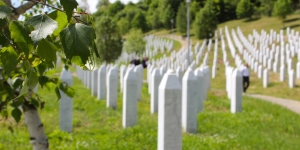Sie sind hier
Srebrenica Gedenkjahr: Filmmaterial
"Srebrenica - A Cry from the Grave" tells the story of the Srebrenica massacre of 1995, in which the Bosnian Serb army killed an estimated 7,000 Bosnian Muslims.
It follows hour by hour the story of the killings. Through the testimony of survivors and relatives of those who died it explores the pain felt when no one is brought to justice.There are interviews with investigators from the UN-sponsored court at The Hague and from the UN special prosecutor.
But the underlying message of the film is bleak indeed - no matter what is done, it will never be enough. A Cry from the Grave has won numerous prizes. It has been shown at the UN, and it was used during a war crimes trial at The Hague.
Lost Images - Bosnia
Everyone remembers the harrowing footage of the Srebrenica massacre shot by Zoran Petrovic, the only cameraman to capture the event. But this fascinating documentary shows that the very worst of his pictures never reached our TV screens. Key scenes were 'lost' or blacked over. Now his incriminating material is available for scrutiny. Chief prosecutor at the War Crimes Tribunal, Mark Harmon, affirms: "It's very important footage. Pictures do not lie".
Podiumsdiskussion in der Heinrich-Böll-Stiftung zu dem Film "Himmel über Srebrenica"
Es diskutieren:
General Manfred Eeisele, Generalmajor a. D. und von 1994 bis 1998 Assistant Secretary General for Planning and Support of Peacekeeping Operations der Vereinten Nationen (UNO)
Dr. Axel Hagedorn, Anwalt von rund 8.000 Hinterbliebenen der Opfer des Srebrenica-Massakers
Prof. Dr. Herfried Münkler, Politikwissenschaftler, Professor für politische Theorie an der Humboldt-Universität zu Berlin
Marieluise Beck, MdB Bündnis90/Die Grünen, Vorsitzende der Deutsch-Bosnisch-Herzegowinischen Parlamentariergruppe des Deutschen Bundestags
Huub Jaspers, Journalist, gewann für seine Recherchen zu Srebrenica 2006 den niederländisch-flämischen Preis für investigativen Journalismus
Caroline Fetscher, Der Tagesspiegel. Autorin u.a. von „Srebrenica. Ein Prozess" (Suhrkamp, 2002).
War Criminals - Bosnia
Bosnian Serb Police Chief, Simo Drljaca, killed by NATO forces, was indicted for setting up Omarska concentration camp near Prijedor, Bosnia. Documents Drljaca's war crimes and his protection by the Serb authorities. Omarska survivors confirm the atrocities of Drljaca and his troops. Local judge, Adil Draganovic, who knew Drljaca and was imprisoned at Omarska, tells of Drljaca's role in the killings. ".. as the head of the police he was responsible for the liquidation of thousands of people from Prijedor." While tracking down Simo Drljaca and Dr Milan Kovacevic, the film crew is questioned by Serbian State Security, then detained by Serb police for secretly filming in Kozarecs, near Prijedor. Former Prijedor residents, who live in Germany, admit they are afraid to return while war criminals are still free. Mustafa Saban's family was 'ethnically cleansed' from Prijedor. After an emotional reunion with son Refik, Mustafa vows never to return home. In Sanski Most, pathologists identify bodies exhumed from mass graves. At a memorial service tearful families honour those killed. The Serb authorities' obstruction of the crew's investigations forms the backdrop to the report.
Der Tunnel von Sarajevo
Er war nur 90 cm breit, 1,60 m hoch und 800 m lang und rettete doch einer ganzen Stadt das Leben. Zum ersten Mal erzählt ein Dokumentarfilm die Geschichte des geheimen Tunnels von Sarajevo, der am längsten eingekesselten Stadt des 20. Jahrhunderts. Während der Belagerung der Stadt von 1992 bis 1996 wurde dieser schmale Tunnel unter dem Flughafenfeld zur Lebensader für über 300 000 Menschen.
Sky too high soil too hard
The film " SKY TOO HIGH, SOIL TOO HARD" is the story about four young people who had the misfortune of leading different lives from their peers in the world. Today they are young, successful and above the evil they were exposed to. While other children were offered the variety of food to choose from, they did not have anything to eat. While the other children were forming their taste in music, the protagonists of this film did not know what the radio was. The other children were taking trips and excursions, while one of the characters of this film was searching the garbage dump for food to survive. Nevertheless, today they are mature and clever enough to know bad and evil.
The Murder of Yuogslavia
The topic of this excellent documentary is war in Bosnia from 1992-1995 as well as the collapse of former Yugoslavia in 1991. The documentary is full of original photo material and it is considered to be one of the most accurate documentaries in English language about Bosnian war.






